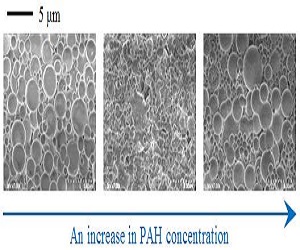
Eri Yoshida
Toyohashi University of Technology, Japan
Title: Artifi cial biomembrane models using polymer giant vesicles: Morphological changes and enhanced permeability of the vesicles by incorporation of ionic segments into the polymer amphiphiles
Biography
Biography: Eri Yoshida
Abstract
Microsized giant vesicles comprised of an amphiphilic poly(methacrylic acid)-block-poly(methyl methacrylate-randommethacrylic acid) diblock copolymer, PMA-b-P(MMA-r-MA), are possible artifi cial models of biomembrane for cells and organelles based on the similarities in their size and structure. Th e similarities include morphological variation based on critical packing shape of the diblock copolymer, membrane fusion and fission and stimulus-responsiveness. Th is paper describes the morphological changes in the vesicles by incorporation of ionic segments into the hydrophilic PMA block and the transformation by electrostatic interaction with a polyelectrolyte on the hydrophilic surface of the vesicles. Th e permeability enhancement of the vesicle bilayer by incorporation of the ionic segments into the hydrophobic P(MMA-r-MA) block is also described. Th e morphological changes in the spherical vesicles were investigated by incorporation of the 3-sulfopropyl methacrylate potassium salt (SpMA) into the hydrophilic PMA block. Th e vesicles were reduced in size as the SpMA units increased due to the expansion of the hydrophilic surface area for critical packing shape of the copolymer by the incorporation of the more hydrophilic ionic segments. Th e increase in the SpMA units delayed the transition from the spherical vesicles to a sheet-like bilayer. Th e SpMA-containing vesicles were disrupted into a nonspecifi c form by the electrostatic interaction with poly(allylamine hydrochloride) (PAH). A large excess of the polyelectrolyte caused partial fusion of the vesicles rather than disruption (Figure-1).

The vesicles with the SpMA incorporated into the hydrophobic P(MMA-r-MA) block also changed from spherical to sheet-like as the SpMA units increased. Th e SpMA units enhanced the permeability of Rhodamine B (Rh) into the vesicle bilayer, whereas the vesicles without SpMA captured no Rh molecules. It was demonstrated that this permeability enhancement was attributed to the pore formation in the bilayer by the capture and release of the Rh by the SpMA units in the hydrophobic phases.

